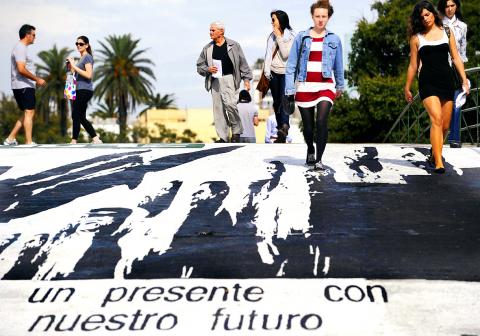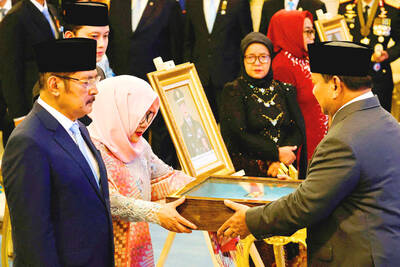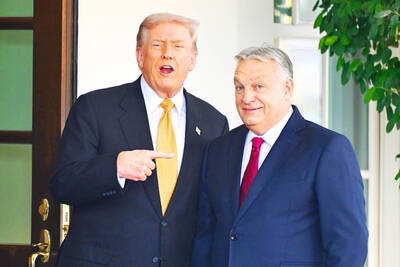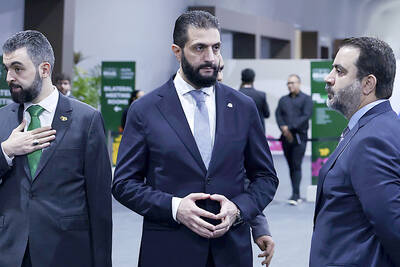A portrait of a murdered activist stares from the graffiti on the wall, a slogan makes a passer-by smile, a colorful pastiche turns visitors’ heads: Welcome to the city where the walls talk.
“Buenos Aires has become a haven for street art, like Sao Paulo and Mexico City,” said Fernando Aita, one of several young editors of the project Grafiti escritos en la calle (Graffiti street writings).
His Web site, which encourages fans to “look at the city through different eyes,” has compiled 1,000 photographs of graffiti art dating back to 2009 in a remarkable visual and linguistic archive of modern times in Argentina.

Photo: AFP
“Plants do not bite,” “A present for our future” and “The fight continues” are among the phrases that stop passers-by in their tracks, amid a flourishing collection of colorful frescoes.
“It’s difficult to speak of graffiti as the city’s heritage because they are ephemeral, but it’s true that street art is part of Buenos Aires,” said Luis Grossman, who heads the city’s historical center.
He supports the blossoming of graffiti which he says “embellishes the city.”
However, the scribblings are also a menace. The Cabildo colonial building, where an uprising on May 25, 1810, sparked a revolution, is constantly tagged. Authorities have spent huge sums repainting it, in vain.
Graffiti Mundo, a local firm, is tapping into a touristic goldmine by organizing guided tours of the city’s best frescoes.
Even tragedy finds a place among the writings on the wall.
“No more Cro-Magnon,” wrote the parents of victims who perished in a fire at the club of the same name in December 2004 that left 194 people dead.
Another graffito reads “Caution: they are armed and at large,” a reference to alleged police brutality, complete with a stencil of a policeman’s cap next to the warning.
These walls can speak, providing a detailed account of how Argentine society has evolved over the past 10 years.
“In 2002, in the middle of Argentina’s economic crisis, the graffiti was even more political,” said Lelia Gandara, an expert in the study of signs and symbols at the University of Buenos Aires. “People were expressing their anger and outrage.”
Aita explained that after those fury-filled times, “more colored frescoes began appearing. And now, hip-hop tags are prevalent.”
However, political commentary regained a graffiti foothold after the death of former Argentine president Nestor Kirchner in October last year.
He was featured on walls as the character “Nestornauta,” a reference to sci-fi comic El Eternauta, created by comic strip writer Hector Oesterheld, who was kidnapped and killed under the country’s 1976 to 1983 dictatorship with his three daughters.
Mariano Ferreyra, a student killed last year by union activists, is also a popular character in the graphics dotted across the city.
Another popular figure is Julio Lopez, the first person to go missing after democracy was restored in Argentina. He was kidnapped in 2006 after testifying against policemen for crimes committed under the military dictatorship.
Along Defensa Street, one of the oldest in the San Telmo neighborhood home to many antique dealers, a cartoon cow, painted every 30m, asks: “Who is thinking about us?”
Scenes of people dancing the tango are further down the street.
“The streets used to be gloomy. Painting the walls brings a little bit of joy,” said Jaz, a 29-year-old screenwriter who has had a passion for graffiti since he was a teenager. “It’s my way of making the city mine.”
Jaz acknowledged street painting is illegal, “but the government and the police turn a blind eye as they have more important problems to deal with.”
Sometimes even homeowners give in to the treand and order custom frescoes to decorate their walls.

James Watson — the Nobel laureate co-credited with the pivotal discovery of DNA’s double-helix structure, but whose career was later tainted by his repeated racist remarks — has died, his former lab said on Friday. He was 97. The eminent biologist died on Thursday in hospice care on Long Island in New York, announced the Cold Spring Harbor Laboratory, where he was based for much of his career. Watson became among the 20th century’s most storied scientists for his 1953 breakthrough discovery of the double helix with researcher partner Francis Crick. Along with Crick and Maurice Wilkins, he shared the

OUTRAGE: The former strongman was accused of corruption and responsibility for the killings of hundreds of thousands of political opponents during his time in office Indonesia yesterday awarded the title of national hero to late president Suharto, provoking outrage from rights groups who said the move was an attempt to whitewash decades of human rights abuses and corruption that took place during his 32 years in power. Suharto was a US ally during the Cold War who presided over decades of authoritarian rule, during which up to 1 million political opponents were killed, until he was toppled by protests in 1998. He was one of 10 people recognized by Indonesian President Prabowo Subianto in a televised ceremony held at the presidential palace in Jakarta to mark National

US President Donald Trump handed Hungarian Prime Minister Viktor Orban a one-year exemption from sanctions for buying Russian oil and gas after the close right-wing allies held a chummy White House meeting on Friday. Trump slapped sanctions on Moscow’s two largest oil companies last month after losing patience with Russian President Vladimir Putin over his refusal to end the nearly four-year-old invasion of Ukraine. However, while Trump has pushed other European countries to stop buying oil that he says funds Moscow’s war machine, Orban used his first trip to the White House since Trump’s return to power to push for

LANDMARK: After first meeting Trump in Riyadh in May, al-Sharaa’s visit to the White House today would be the first by a Syrian leader since the country’s independence Syrian President Ahmed al-Sharaa arrived in the US on Saturday for a landmark official visit, his country’s state news agency SANA reported, a day after Washington removed him from a terrorism blacklist. Sharaa, whose rebel forces ousted long-time former Syrian president Bashar al-Assad late last year, is due to meet US President Donald Trump at the White House today. It is the first such visit by a Syrian president since the country’s independence in 1946, according to analysts. The interim leader met Trump for the first time in Riyadh during the US president’s regional tour in May. US envoy to Syria Tom Barrack earlier